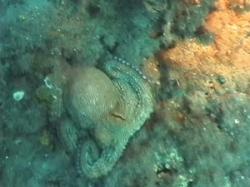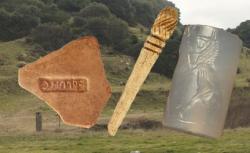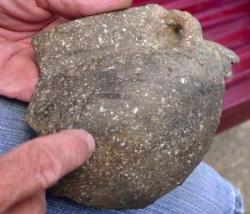INSTITUT SUPERIEUR D'ANTHROPOLOGIE
INSTITUTE OF ANTHROPOLOGY
ONLINE COURSES / COURS A DISTANCE
INSCRIPTION 2012 / Session III : Juillet 2012
REGISTRATION 2012 / Term III : July 2012
GRECE –  Skiathos - Underwater explorations from May 14 though 25 near Skiathos island resulted in a treasure trove of archaelogical antiquities. The first organized underwater exploration was held under the supervision of the Greek Ephorate of Underwater Antiquities and explored through areas including the old port of Skiathos, notable for the Venetian fortress called Burtzi, Kehria area and others. An ancient breakwater as well as a Byzantine jetty were uncovered in the area around the ancient port, which precisely coincides with the modern harbor of Skiathos. Around the old harbor were also discovered many pieces of ceramic jars. The most important findings were two complete lamps dated back to the 4th and 6th century, as well as two complete jars of the late classical period. At the Tarsanades region, the specialized divers found part of a shipwreck of late Roman times, while at a close distance to the old harbour was also found a shipwreck from Byzantium carrying mostly roof tiles and parts of Byzantine jars. Another shipwreck of the late Roman era was found at Platania cove.
Skiathos - Underwater explorations from May 14 though 25 near Skiathos island resulted in a treasure trove of archaelogical antiquities. The first organized underwater exploration was held under the supervision of the Greek Ephorate of Underwater Antiquities and explored through areas including the old port of Skiathos, notable for the Venetian fortress called Burtzi, Kehria area and others. An ancient breakwater as well as a Byzantine jetty were uncovered in the area around the ancient port, which precisely coincides with the modern harbor of Skiathos. Around the old harbor were also discovered many pieces of ceramic jars. The most important findings were two complete lamps dated back to the 4th and 6th century, as well as two complete jars of the late classical period. At the Tarsanades region, the specialized divers found part of a shipwreck of late Roman times, while at a close distance to the old harbour was also found a shipwreck from Byzantium carrying mostly roof tiles and parts of Byzantine jars. Another shipwreck of the late Roman era was found at Platania cove.
http://greece.greekreporter.com/2012/06/11/ancient-artefacts-discovered-underwater-skiathos-island/
GRECE –  Argastali - Région du Pélion : Deux sites archéologiques ont été repérés près d'Argastali, l'un occupé jusqu'à l'époque classique, l'autre datant de l'âge du Bronze
Argastali - Région du Pélion : Deux sites archéologiques ont été repérés près d'Argastali, l'un occupé jusqu'à l'époque classique, l'autre datant de l'âge du Bronze
http://www.taxydromos.gr/article.php?id=47593&cat=1
FRANCE –  Vendeuvre - Johan Durand doctorant en Archéologie antique a été invité par les Amis de la Pallu à présenter vendredi dernier les premiers résultats de sa dernière campagne de fouilles programmées, réalisée l'été dernier sur le site gallo-romain des Tours Mirandes à Vendeuvre. Dans le cadre de sa thèse de doctorat en archéologie portant sur l'architecture, l'urbanisme et les fonctions de cette vaste agglomération antique (130-140 ha) du 1er et IIe siècle apr. JC, il a fait en effet depuis 2010 deux campagnes de fouilles dans deux îlots d'habitat d'une surface totale 1.600 m2 afin de comprendre la vie quotidienne des habitants. Cette agglomération appartenant à un réseau de cités antiques présentes autour de la capitale Lemonum (Poitiers) était jusque-là connue pour avoir eu un riche ensemble monumental, vastes esplanades, théâtre de 7.000 personnes, monument circulaire, monument type basilical….qui ont longtemps focalisé l'intérêt des premiers chercheurs. L'été dernier, les fouilles de maisons (du Ier siècle apr. JC) notamment d'une maison supérieure à 500 m2 ont révélé des constructions et des reconstructions évoquant différents niveaux d'occupation. Elles ont également permis de trouver des foyers domestiques au sol, une cave de construction très soignée et surtout des enduits peints, éléments de décoration qui après avoir été soigneusement mis au jour puis redessinés précisément et traités par des archéologues spécialistes ont fait l'objet d'une reconstitution sur ordinateur donnant une idée de l'intérieur d'une maison en trois dimensions. Des décors peints de couleurs, rouge, jaune et noir et dans une des pièces avec des motifs de feuilles et de bouquets. Cet été du 2 juillet au 31 août de nouvelles fouilles seront dirigées par Johan Durand.
Vendeuvre - Johan Durand doctorant en Archéologie antique a été invité par les Amis de la Pallu à présenter vendredi dernier les premiers résultats de sa dernière campagne de fouilles programmées, réalisée l'été dernier sur le site gallo-romain des Tours Mirandes à Vendeuvre. Dans le cadre de sa thèse de doctorat en archéologie portant sur l'architecture, l'urbanisme et les fonctions de cette vaste agglomération antique (130-140 ha) du 1er et IIe siècle apr. JC, il a fait en effet depuis 2010 deux campagnes de fouilles dans deux îlots d'habitat d'une surface totale 1.600 m2 afin de comprendre la vie quotidienne des habitants. Cette agglomération appartenant à un réseau de cités antiques présentes autour de la capitale Lemonum (Poitiers) était jusque-là connue pour avoir eu un riche ensemble monumental, vastes esplanades, théâtre de 7.000 personnes, monument circulaire, monument type basilical….qui ont longtemps focalisé l'intérêt des premiers chercheurs. L'été dernier, les fouilles de maisons (du Ier siècle apr. JC) notamment d'une maison supérieure à 500 m2 ont révélé des constructions et des reconstructions évoquant différents niveaux d'occupation. Elles ont également permis de trouver des foyers domestiques au sol, une cave de construction très soignée et surtout des enduits peints, éléments de décoration qui après avoir été soigneusement mis au jour puis redessinés précisément et traités par des archéologues spécialistes ont fait l'objet d'une reconstitution sur ordinateur donnant une idée de l'intérieur d'une maison en trois dimensions. Des décors peints de couleurs, rouge, jaune et noir et dans une des pièces avec des motifs de feuilles et de bouquets. Cet été du 2 juillet au 31 août de nouvelles fouilles seront dirigées par Johan Durand.
http://www.lanouvellerepublique.fr/Vienne/communes/Vendeuvre-du-Poitou/n/Contenus/Articles/2012/06/10/Le-passe-des-Tours-Mirandes-reconstitue
INDE –  Elenthikara - Elenthikara High School, near North Paravur, has a history. The playground has a prominent gradient. When it rains the top soil gets washed off revealing the rims of a series of burial urns inhumed in a sort of systematic pattern. This is, as many archaeologists believe the biggest site of burial urns in one single location, in the State. Though the earliest reports of this site were recorded way back in the year 2000, this archeologically and historically megalithic monuments lies unprotected, unknown, unacknowledged. Nearly 30 years back a huge urn was dug out rather unprofessionally by the children of the school when they were cleaning up the compound. Then, five years back, the ‘Puzha Kuttikootam' (children's group), as part of their study of the history and culture of the village, cleared up part of the ground revealing the rims of numerous urns. A lot of people, experts, archaeologists, members of Mysore Historical Society, who were here as part of another project, visited the place. They told us that the urns must be from the period dated between 5000 B.C.-3000 B.C. The importance of this site is that it may unravel secrets of a bygone culture that might have spread its roots to other regions of the district. But sadly this site has been unprotected. Children still use this playground, parts of the exposed urns are very often chipped off and every time the ground is levelled or expanded slices of valuable history has been disappearing. Elenthikara is strategically situated at the confluence of the Chalakudy and Periyar rivers. “This is proof that the burial urn site should be historically important. There must have been a settlement nearby and this must have been the burial place. Similar sites elsewhere have yielded valuable objects that are pointers to a lost culture. So, investigations must be done here,” feels Dr. S. Hemachandran, former director, State Archaeology.
Elenthikara - Elenthikara High School, near North Paravur, has a history. The playground has a prominent gradient. When it rains the top soil gets washed off revealing the rims of a series of burial urns inhumed in a sort of systematic pattern. This is, as many archaeologists believe the biggest site of burial urns in one single location, in the State. Though the earliest reports of this site were recorded way back in the year 2000, this archeologically and historically megalithic monuments lies unprotected, unknown, unacknowledged. Nearly 30 years back a huge urn was dug out rather unprofessionally by the children of the school when they were cleaning up the compound. Then, five years back, the ‘Puzha Kuttikootam' (children's group), as part of their study of the history and culture of the village, cleared up part of the ground revealing the rims of numerous urns. A lot of people, experts, archaeologists, members of Mysore Historical Society, who were here as part of another project, visited the place. They told us that the urns must be from the period dated between 5000 B.C.-3000 B.C. The importance of this site is that it may unravel secrets of a bygone culture that might have spread its roots to other regions of the district. But sadly this site has been unprotected. Children still use this playground, parts of the exposed urns are very often chipped off and every time the ground is levelled or expanded slices of valuable history has been disappearing. Elenthikara is strategically situated at the confluence of the Chalakudy and Periyar rivers. “This is proof that the burial urn site should be historically important. There must have been a settlement nearby and this must have been the burial place. Similar sites elsewhere have yielded valuable objects that are pointers to a lost culture. So, investigations must be done here,” feels Dr. S. Hemachandran, former director, State Archaeology.
http://www.thehindu.com/life-and-style/article3509051.ece
USA –  Sangamon River - A mysterious fragment of American Indian pottery discovered on a sandbar in the Sangamon River has archaeologists wondering about its origin and the people who made it. Michael Wiant, director of Dickson Mounds Museum near Lewistown, says the pottery, made by the Oneota people, is a significant find. Scott Hewitt, who routinely guides canoe and kayak trips on the river, found the artifact May 27 on a sandbar in a bend in the Sangamon between Springfield and Petersburg. When he stopped to dig it up, the rock turned out to be part of a pot created by the Oneota people, a group that once lived in Iowa, Minnesota, Wisconsin and parts of northern Illinois. The Oneota inhabited Illinois about 700 years ago, 300 years before the first French traders arrived. “The Oneota culture is something we know arrives in Illinois circa 1300,” Wiant said. “We’ve known about four or five sites on the Illinois River and had a hint there was one on Salt Creek.” However, he said, “Both this find and the Salt Creek find are well out of the range where we expected to find this material.” The Oneota people who made the piece of pottery found on the Sangamon River left their own distinctive signature in its design. “People tend to make things in a way that is consistent with their culture,” said Michael Wiant, director of the Dickson Mounds Museum. “What you tend to see (in Oneota pottery) are these bold, incised lines in a variety of geometric forms.” The artisans used small sticks to make lines, points and shapes in the wet clay. “They are taking the end of a round stick and poking it into the clay and taking the broad end of a stick about 1/8th inch broad and making nested triangles,” he said. “So the design pallet and sequence of Oneota is quite distinctive. “This particular pot has some of those distinctive markings,” Wiant said. “There are (markings) on the loop handles that go from the rim to the vessel side, and notches on the inside of the rim and bold marks on the shoulder of the pot.” Researchers are in the fifth year of a study examining a village site overlooking the Illinois River Valley that at one time was home to both Mississippian and Oneota cultures. Excavations are under way in the second week of a six-week field season at the site, which is known as the Morton Village. But researchers are finding some overlap. Some Mississippian buildings had Oneota artifacts inside, while other buildings were built in Mississippian style, but rebuilt later with Oneota techniques. “If the buildings were abandoned and rebuilt later, they weren’t abandoned for very long,” Conner said. “Soon, we should be able to say if they were there together or not.” If the two cultures occupied the site at the same time, the question is whether they got along. A cemetery excavated in the 1980s, before a road project came through, revealed that many buried there had died violently. “The Oneota were in conflict with someone, but we don’t know with whom,” Conner said. “They had a complex social structure. They may have allied with some Mississippians while they were fighting with others. “Or they may have been fighting with some groups from outside.”
Sangamon River - A mysterious fragment of American Indian pottery discovered on a sandbar in the Sangamon River has archaeologists wondering about its origin and the people who made it. Michael Wiant, director of Dickson Mounds Museum near Lewistown, says the pottery, made by the Oneota people, is a significant find. Scott Hewitt, who routinely guides canoe and kayak trips on the river, found the artifact May 27 on a sandbar in a bend in the Sangamon between Springfield and Petersburg. When he stopped to dig it up, the rock turned out to be part of a pot created by the Oneota people, a group that once lived in Iowa, Minnesota, Wisconsin and parts of northern Illinois. The Oneota inhabited Illinois about 700 years ago, 300 years before the first French traders arrived. “The Oneota culture is something we know arrives in Illinois circa 1300,” Wiant said. “We’ve known about four or five sites on the Illinois River and had a hint there was one on Salt Creek.” However, he said, “Both this find and the Salt Creek find are well out of the range where we expected to find this material.” The Oneota people who made the piece of pottery found on the Sangamon River left their own distinctive signature in its design. “People tend to make things in a way that is consistent with their culture,” said Michael Wiant, director of the Dickson Mounds Museum. “What you tend to see (in Oneota pottery) are these bold, incised lines in a variety of geometric forms.” The artisans used small sticks to make lines, points and shapes in the wet clay. “They are taking the end of a round stick and poking it into the clay and taking the broad end of a stick about 1/8th inch broad and making nested triangles,” he said. “So the design pallet and sequence of Oneota is quite distinctive. “This particular pot has some of those distinctive markings,” Wiant said. “There are (markings) on the loop handles that go from the rim to the vessel side, and notches on the inside of the rim and bold marks on the shoulder of the pot.” Researchers are in the fifth year of a study examining a village site overlooking the Illinois River Valley that at one time was home to both Mississippian and Oneota cultures. Excavations are under way in the second week of a six-week field season at the site, which is known as the Morton Village. But researchers are finding some overlap. Some Mississippian buildings had Oneota artifacts inside, while other buildings were built in Mississippian style, but rebuilt later with Oneota techniques. “If the buildings were abandoned and rebuilt later, they weren’t abandoned for very long,” Conner said. “Soon, we should be able to say if they were there together or not.” If the two cultures occupied the site at the same time, the question is whether they got along. A cemetery excavated in the 1980s, before a road project came through, revealed that many buried there had died violently. “The Oneota were in conflict with someone, but we don’t know with whom,” Conner said. “They had a complex social structure. They may have allied with some Mississippians while they were fighting with others. “Or they may have been fighting with some groups from outside.”
http://www.sj-r.com/top-stories/x465792191/Fragment-of-Indian-pottery-creates-mystery?zc_p=2